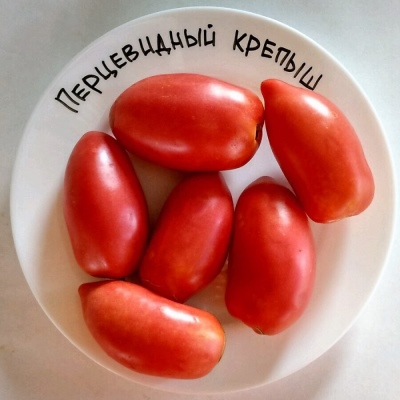
- Authors: Dederko V.N., Postnikova O.V.
- Year of approval: 2017
- Category: grade
- Growth type: determinant
- Appointment: fresh consumption
- Ripening period: mid-early
- Ripening time, days: 105-110
- Growing conditions: for open ground
- Marketable fruit yield,%: 95,5%
- Bush size: undersized
Pepper tomatoes have occupied a solid niche in the collections of most gardeners and connoisseurs of this berry, although it's no secret - it's impossible not to love tomatoes. The category differs not only in appearance. All fruits have a subtle taste difference - an ideal balance of sugar and acid. The variety is in great demand among both farmers and consumers.
The strong pepper is characterized as a determinant, unpretentious variety intended for outdoor cultivation and fresh consumption, although many use it in various preserves.
Breeding history
The variety was bred by breeders of Western Siberia Dederko V.N. and Postnikova O.V. The variety was registered in the State Register of Breeding Achievements in 2017.
Description of the variety
Standard undersized (30–40 cm) compact bushes are covered with gray-green, slightly pubescent foliage with a traditional dissection of the edges. The leaf has a strong classic tomato flavor. Yellow flowers are collected in simple inflorescences.
The variety is distinguished by a high yield of marketable fruits (95.5%). The plant is unpretentious, gratefully responds to the introduction of organic and mineral dressings, does not need formation and pinching, has a strong immunity, early maturity, excellent taste and visual appeal.
It is difficult to find the disadvantages of the Strong Pepper, except that with a good harvest, the bushes need to be tied, otherwise they will simply fall due to the weight of the pouring berry.
The main qualities of the fruit
Beautiful pepper-shaped fruits are collected in dense clusters. Green berries gradually change the palette to deep pink shades during technical and physiological ripeness. The average size and weight in the range of 140 grams allows for whole-fruit canning.
Taste characteristics
The sweet crumbly pulp is accompanied by a pleasant sourness. The section shows 4 seed chambers with a limited number of seeds. The skin of medium density is almost invisible when eating. Unfortunately, it is this factor that does not allow transporting crops over long distances. The sale of products takes place at grocery points located near the place of cultivation. Tomatoes are rich in vitamins, amino acids.
Ripening and fruiting
The variety belongs to the mid-early category, the yield is friendly, with a small percentage of lagging behind a certain number of fruits. The approximate ripening period is 105-110 days.
Yield
The average yield is 388 centners per hectare.
The timing of planting seedlings and planting in the ground
Sowing seeds is carried out 50-60 days before planting in the ground. Depending on the region, this is the beginning or mid-April.

Growing tomato seedlings is an extremely important process, because it largely depends on whether the gardener will be able to harvest at all. All aspects must be taken into account, from seedbed preparation to planting in the ground.
Landing scheme
The optimal planting pattern is 3 to 5 roots per square meter.

Growing and care
The strong pepper is grown in seedlings, before the transfer of young plants, the seedlings are hardened. Containers with seedlings are gradually accustomed to sunlight, temperature changes in the environment. A plot in the garden is chosen sunny, it cannot be planted in low-lying wetlands - an excess of moisture leads to inhibition of development and the appearance of phytophthora.
The land in the ridges is enriched with organic matter (humus, compost, bird droppings), complex fertilizers, superphosphate, wood ash. Tomatoes do not like highly acidic soils, therefore, soil with a high pH level needs to be deoxidized with chalk, gypsum, dolomite flour, and lime fluff. The introduction of fresh manure is permissible only in the fall for digging.
Further care consists in weeding, loosening, hilling. Loosening is an excellent substitute for mulching the soil. Watering is carried out no more than 1 time in 10-15 days. In a rainy period, irrigation is completely canceled, in a dry period, the interval can be slightly reduced.
The first feeding is carried out 10 days after transplanting to a permanent place. At this time, the culture is actively increasing its vegetative mass and needs nitrogen. During the budding period, phosphorus-potassium compounds are introduced, during the season they are watered several times with infusion of nettle or mullein.




A plant needs different micronutrients at each stage of growth. All fertilizers can be divided into two groups: mineral and organic. Folk remedies are often used: iodine, yeast, bird droppings, eggshells.
It is important to observe the rate and period of feeding. This also applies to folk remedies and organic fertilizers.
Disease and pest resistance
The variety is distinguished by an enviable ability to withstand almost all diseases, in particular TMV, but waterlogging is dangerous due to late blight. The foliage of the Strong Pepper is not liked by almost all pests, and yet preventive treatments with insecticides and fungicides are necessary.


Resistant to adverse weather conditions
The Siberian variety copes well with temperature extremes, cold snaps and does not feel very well in prolonged rainy weather.
Growing regions
The variety, bred in Western Siberia, grows equally well in warm and cold climates - the northern, North-Western, Central, Volgo-Vyatsky, TsChO, North Caucasian, Srednevolzhsky, Nizhnevolzhsky, Uralsky, West Siberian, East Siberian, Far Eastern regions ...

























































































